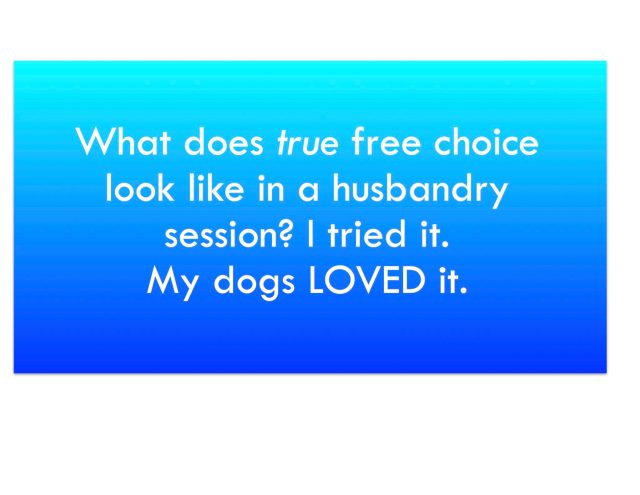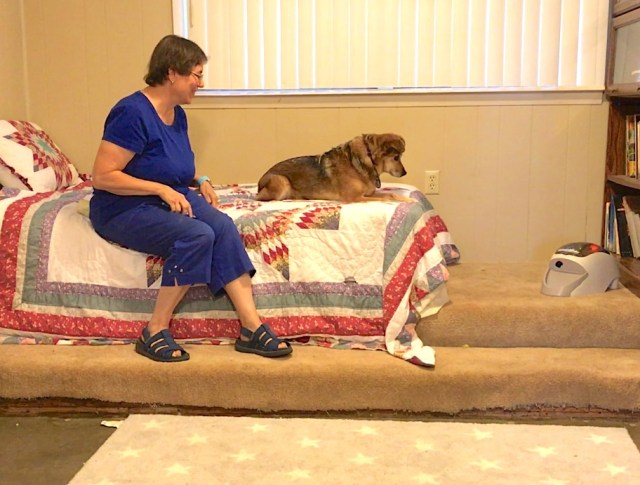Barks Blog
If You’re Loving It, Why Leave?
Is “choice” a code word for negative reinforcement?
It can be. Seems like that’s the context where I see it pop up the most.
I’ve written a lot about choice. Two of my major points are:
- Many people are confused about using choice as an antecedent vs. a consequence; and
- People are rarely referring to choices between positive reinforcers when they write about their animals having a choice.
But here’s another thing that gets under my skin. These days it seems like many people who use the language of choice to describe their training are referring to the fact that they permit the animal to leave as relief from a difficult task. For instance, in a husbandry session, the dog may receive a food reinforcer for cooperative behavior. That constitutes positive reinforcement if we see cooperative behavior (usually staying still or focusing on something) increase or maintain. 1) The dog is allowed to leave as often as she wants. The session starts back up if she returns. The leaving constitutes negative reinforcement if we see leaving increase or maintain. But remember: escape is only a reinforcer if the activity is unpleasant.
Letting the dog leave is a good thing. But there is a big drawback if it is planned on as an expected response and built into a protocol.
Building escape behavior into a protocol can provide a disincentive to the human to make the process as pleasant for the dog as possible. Rather than working harder to create a situation where the dog doesn’t want to leave, the trainer can focus on saying that the dog is “empowered” by the ability to leave. On the contrary, some trainers, including myself, consider a dog repeatedly leaving as evidence that we have not worked hard enough at making the experience pleasant. It’s a failure, not a goal. It means we didn’t set up our antecedents and graduated exposures well enough.
Forced vs. Free Choice
I have written about forced and free choice before. Forced choice applies to our husbandry example. The dog can stick with the session and get food or another appetitive stimulus, or the dog can leave. Leaving usually leads to an environment that is bare of other positive reinforcers, or has very weak ones. We deliberately set things up that way as an incentive for the dog to stick with the session. There is no shame in that. Controlling other reinforcers is a part of positive reinforcement-based training. But bragging that escape offers the animal empowerment when the other option is bare of interesting activities is a bit strained.
Also, the presence of food can be coercive. The husbandry session may be unpleasant but the food quite good. Hence, the dog is putting up with discomfort to get the food. Again, sometimes we have to perform medical or husbandry tasks that are painful. But why start out that way if we don’t have to?
On the other hand, free choice is a choice between two appetitive stimuli: two good/fun/nice things. Two things the dog will work for. For instance, stay inside and be petted (for a dog who likes that) or go outside and play ball. Play with this toy, then that one. Dig in the yard or lie in the sunshine.
Is there a way to offer free choice between two appetitive stimuli in a husbandry session? Sure, and I tried it. My dogs LOVED it.
If You Really Want to Give the Dog a Free Choice…
…you have to stop controlling other options for reinforcement. Instead, offer another option. In my case, I set up for a husbandry session, but provided another reinforcement option in the form of a Manners Minder, an automated treat dispenser.
I loaded it with the same treats I was using and placed it a few feet away. I set it to eject treats on a variable interval schedule. My intention was for the Manners Minder’s rate of treat delivery and mine to be similar. It would eject treats every so often no matter what the dog was doing (no contingency from me). But the dog’s behavior of leaving the husbandry session could be positively reinforced.
I started a nail clipping session with the video camera running.
This unedited movie shows the very beginning, where Zani is still figuring out what the deal is. Is it OK for her to run to the Manners Minder in the middle of our session? (Yes.) Is there a good reason to return for nail clipping? (Yes, because there were gaps in the Manners Minder schedule.) Zani has a genius for optimization and was soon going back and forth.
I was super pleased that husbandry sessions are pleasant enough to her that Zani happily came back. If she hadn’t, that would be valuable information. It would mean I needed to work more on making husbandry pleasant for her. In the meantime, to get the job done, I could stack the deck a little in my favor via treat value or rate of reinforcement. I would have no problem with the ethics of that. In my opinion, it’s still far superior to the scenario where the dog’s only other option is escape to a boring room.
During my other dogs’ first sessions, I needed to call them back a few times. They both tended to get stuck in one place or another because of their reinforcement histories. Thinking it through, I don’t think calling them affects the balance of the two options much. The sound of the Manners Minder is a very strong cue that food is available. Likewise, my calling my dog is a strong cue for the same. I reinforced the dogs for coming back to me when I did so. They were free to leave again right away, but they usually stuck around for a nail clip or two, or until the Manners Minder produced another treat.
In the movie with Zani you can see me using the remote on the Manners Minder. I am turning the down-stay variable interval setting on and off. But in subsequent sessions (not filmed) I just set it and let it alone.
[youtube https://www.youtube.com/watch?v=ibLhszvLc8c?feature=oembed]
Link to the video for email subscribers.
Choice Doesn’t Apply Only To Negative Reinforcement Protocols (Even Though That’s When You Often Hear About It)
One of the things that often gets lost in the discussions about choice is that we offer our dogs a choice every time we give a cue for a positively reinforced behavior. When I call my dog while she’s digging in the dirt in the yard, I have offered her a choice, whether I’m happy about that or not. And it’s a choice between two nice things. But this type of choice is often overlooked because the reason we train dogs is often to get them to do things we want. Offering a dog a choice between two appetitives can be inconvenient for the human. Whereas offering a dog a choice to leave an uncomfortable husbandry session doesn’t cost us much. We know the dog will probably come back because we are the source of R+ in the room. It seems pretty self-serving to me to promote choice primarily when it is easiest for us.
If a trainer or a protocol focuses on choice, ask questions. What are the choices? Ask the trainer or author to operationalize them. Are the choices antecedents or consequences? What will your animal be choosing between? The trainer should be able to tell you whether both of the choices lead to positive reinforcement, or if one leads to positive reinforcement and the other to negative reinforcement (escape).
Don’t Necessarily Try My Experiment at Home
This was an experiment. Our success with the dual reinforcement setup had a lot to do with the dogs’ history with me. Offering a powerful reinforcer for leaving a husbandry session could backfire if a dog didn’t have a strong reinforcement history for staying. I’m not necessarily recommending it. I wrote in another post about the down side of offering a dog between two positive reinforcers and how it can be tricky. That risk is very clear in my game with the Manners Minder.
Another issue is that the dual reinforcement setup as I presented it is not workable for procedures where the dog must stay still, perhaps as in a jugular blood draw. But that’s true for any method that allows the dog to leave. Most of us at some point also train the dog to stay still.
I tried this out because I was curious. I am publishing it because I want folks to see what it can look like for a dog to exercise free choice in a husbandry session. I’m continuing to do it because it makes toenail trims downright fun for my dogs.
Related Posts
- Not All “Choices” Are Equal
- The Dog’s Choice (Choice, Part 2)
- The Choice Challenge
- My Dogs Are Not in Charge
Copyright Eileen Anderson 2016



